Saanen Goat
- February 22, 2024
- 0 comment
The Saanen goat, originating from the Saanen valley in Switzerland, is a remarkable breed highly regarded for its exceptional milk production, friendly demeanor, and adaptability to various climates. These goats are easily identifiable by their pure white coat and erect ears, possessing a medium-to-large frame that showcases their sturdy build. Known for their docile nature, Saanen goats are easy to handle and form strong bonds with their human caregivers.
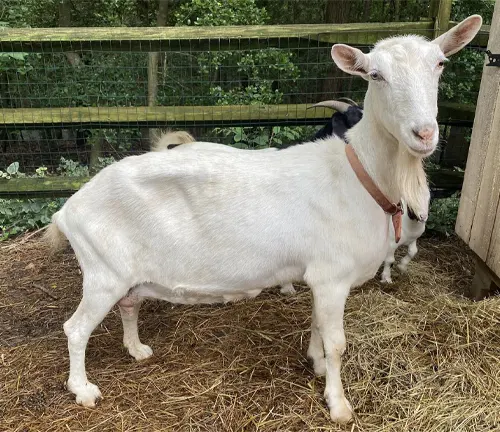
Their calm temperament makes them ideal for both commercial farming operations and hobbyist endeavors. Raising Saanen goats offers numerous benefits, including high milk yields, low maintenance requirements, and suitability for beginners. Providing proper housing, nutrition, and healthcare is essential for ensuring the health and well-being of Saanen goats. With their versatility in dairy farming, meat production, and eco-tourism, Saanen goats continue to be a valuable asset to farmers worldwide.
| Specification | Description |
|---|---|
| Origin | Saanen Valley, Switzerland |
| Coat Color | Pure white |
| Ear Type | Erect |
| Size | Medium to large |
| Weight (Female) | 135 to 150 pounds |
| Weight (Male) | 160 to 200 pounds |
| Temperament | Docile and friendly |
| Milk Production | High |
| Adaptability | Suitable for various climates |
| Maintenance Requirements | Low |
| Suitability | Ideal for beginners and experienced farmers alike |
| Primary Use | Dairy farming, meat production, eco-tourism |
| Lifespan | 12 to 15 years |
| Health Considerations | Prone to diseases such as mastitis, parasites, and hoof rot |
| Special Care | Regular health checks, vaccination, and deworming |
| Environmental Impact | Efficient resource utilization, minimal carbon footprint |
Saanen goats, often referred to as the “Holstein of the goat world,” are a remarkable breed known for their high milk production, calm demeanor, and adaptability to various climates. Originating from the Saanen valley in Switzerland, these goats have gained popularity worldwide for their exceptional qualities.
Origin and History
The origin and history of Saanen goats trace back to the Saanen valley in Switzerland. This picturesque region nestled in the Swiss Alps provided the ideal environment for the development of this remarkable breed. Records indicate that Saanen goats have been bred in the area for several centuries, with their lineage dating back to ancient times. Initially, these goats were prized for their milk production capabilities, which played a vital role in sustaining local communities.

Over time, breeders in the Saanen valley selectively bred these goats to enhance their desirable traits, such as high milk yields, sturdy constitution, and gentle temperament. The breed’s reputation gradually spread beyond Switzerland’s borders, gaining recognition for its exceptional qualities in dairy farming circles worldwide. Today, Saanen goats are one of the most popular dairy goat breeds globally, valued for their prolific milk production, adaptability to various climates, and friendly disposition. The rich history and heritage of the Saanen goat continue to be celebrated by breeders and enthusiasts alike, ensuring its legacy endures for generations to come.
Physical Characteristics
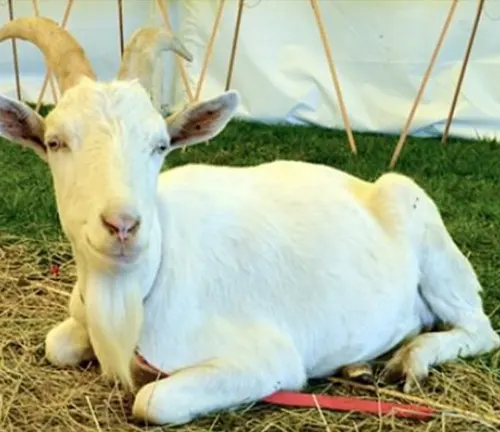
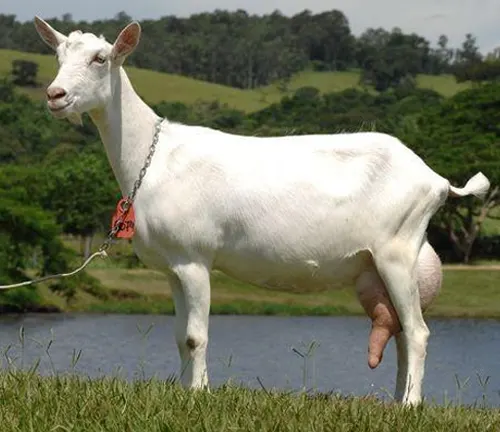
Saanen goats are easily recognizable by their distinct physical characteristics. They typically have a medium-to-large frame, with females ranging in weight from 135 to 150 pounds and males weighing between 160 to 200 pounds. One of the most notable features of Saanen goats is their pure white coat, which is soft and often described as luxurious. Their coat is well-suited for various climates, providing insulation during colder weather while also reflecting sunlight in warmer temperatures. Saanen goats have erect ears that stand alertly on top of their heads, giving them a regal appearance. Their facial profile is straight or slightly dished, with expressive eyes that exude intelligence and curiosity. Overall, Saanen goats possess a graceful and elegant demeanor, making them a favorite among farmers and homesteaders for both their practical utility and aesthetic appeal.
Temperament and Behavior
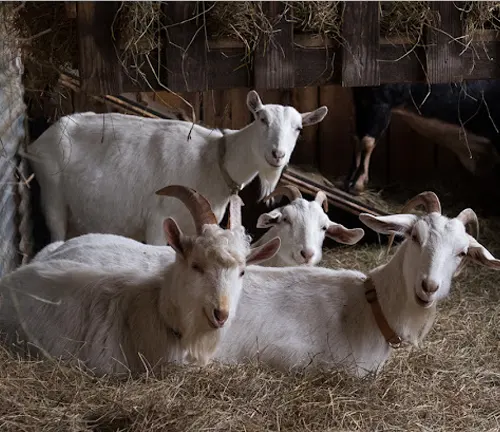

Saanen goats are renowned for their gentle and docile temperament, making them a popular choice for farmers and homesteaders alike. Known for their friendly and sociable nature, Saanen goats easily form strong bonds with their human caregivers. They are often described as affectionate and curious animals, displaying an inquisitive demeanor towards their surroundings. Despite their large size, Saanen goats are remarkably easy to handle, making them suitable for children and novice farmers. Their calm disposition also makes them well-suited for various agricultural settings, as they are less likely to exhibit aggressive behavior or become easily startled. Additionally, Saanen goats are highly adaptable creatures, capable of thriving in different environments and social situations. Whether kept as pets, used for dairy production, or showcased in agricultural exhibitions, Saanen goats consistently impress with their amiable personality and cooperative demeanor.
Benefits of Raising Saanen Goats
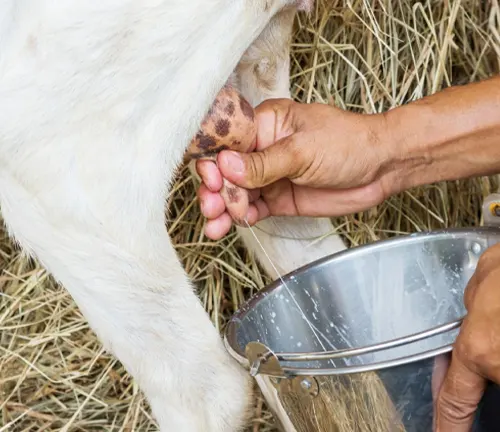
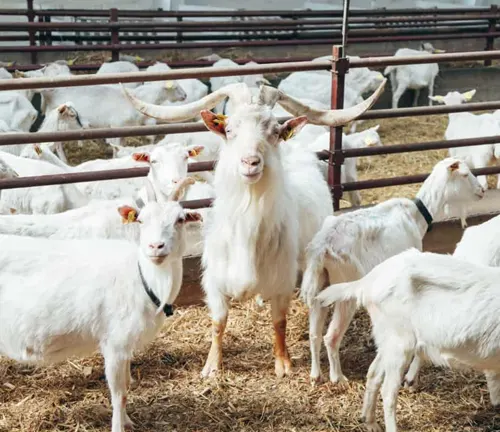
Raising Saanen goats offers a multitude of benefits for farmers, homesteaders, and agricultural enthusiasts alike. Some of the key advantages of raising Saanen goats include:
- High Milk Production: Saanen goats are renowned for their exceptional milk production capabilities. They typically produce a large volume of high-quality milk, making them valuable assets for dairy farming operations.
- Ease of Management: Known for their gentle temperament and cooperative nature, Saanen goats are easy to handle and manage. This makes them ideal for both experienced farmers and beginners looking to enter the world of goat farming.
- Adaptability: Saanen goats are highly adaptable animals capable of thriving in various climates and environmental conditions. Whether raised in hot, arid regions or cold, mountainous areas, Saanen goats can adapt and flourish.
- Versatility: Beyond their primary role as dairy producers, Saanen goats offer versatility in agriculture. They can be utilized for meat production, brush clearing, and even eco-tourism ventures, providing multiple avenues for income generation.
- Economic Viability: With their prolific milk production and low maintenance requirements, Saanen goats can be a profitable investment for farmers. Their ability to convert forage into milk efficiently contributes to their economic viability.
- Gentle Disposition: Saanen goats are known for their friendly and docile nature, making them suitable companions for farmers and homesteaders. Their calm demeanor also enhances safety during handling and milking procedures.
- Breeding Potential: Saanen goats are often used in crossbreeding programs to enhance the milk production of other goat breeds. Their superior genetics and high milk yields make them valuable contributors to breeding initiatives aimed at improving overall herd productivity.
- Community Engagement: Raising Saanen goats can foster community engagement and social interaction. Participating in agricultural events, farmer’s markets, and educational programs can help promote awareness about goat farming and sustainable agriculture practices.
Housing and Shelter Requirements
When it comes to housing and shelter requirements for Saanen goats, several key factors should be considered to ensure their health and well-being.

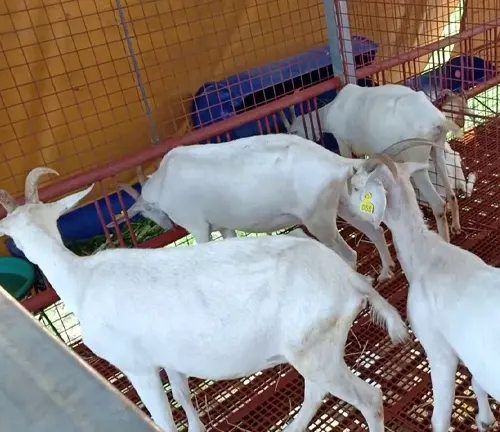
- Shelter Structure: Saanen goats require a sturdy shelter that can protect them from inclement weather conditions such as rain, wind, and extreme temperatures. A well-constructed barn or shelter with a solid roof and walls provides adequate protection against the elements
. - Ventilation: Proper ventilation is essential to maintain air quality and prevent respiratory issues among Saanen goats. The shelter should have adequate windows, vents, or openings to allow for air circulation without exposing the goats to drafts.
- Drainage: Ensuring proper drainage is crucial to prevent water accumulation inside the shelter. The floor should be sloped to allow for water runoff, and drainage channels or gutters can help direct water away from the shelter to prevent flooding.
- Space: Saanen goats require ample space to move around and exhibit natural behaviors. The shelter should be spacious enough to accommodate the entire herd comfortably, with enough room for feeding, resting, and socializing.
- Cleanliness: Maintaining cleanliness is essential to prevent the buildup of waste and minimize the risk of diseases. Regular cleaning and disinfection of the shelter, including floors, walls, and bedding, help create a hygienic environment for the goats.
- Access to Water: Saanen goats need access to clean, fresh water at all times to stay hydrated and healthy. Water troughs or automatic waterers should be installed within the shelter or nearby to ensure easy access for the goats.
- Bedding: Providing comfortable bedding is important to help Saanen goats rest and sleep comfortably. Suitable bedding materials include straw, hay, or wood shavings, which provide insulation and cushioning for the goats.
Feeding and Nutrition
Feeding and nutrition play a crucial role in maintaining the health and productivity of Saanen goats. Here are some important considerations:
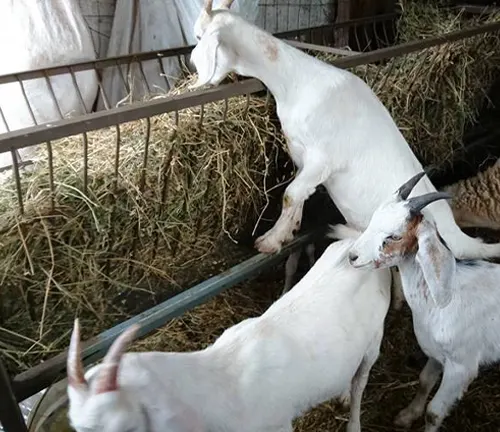

- Forage and Pasture: Saanen goats thrive on a diet rich in forage, including grass, legumes, and browse. Providing access to pasture allows goats to graze freely, meeting their natural dietary preferences and nutritional needs.
- High-Quality Hay: Good-quality hay serves as the foundation of a Saanen goat’s diet, providing essential nutrients such as fiber, protein, vitamins, and minerals. Alfalfa hay is particularly beneficial for its high protein content, which supports milk production in lactating does.
- Supplemental Feeding: In addition to forage and hay, Saanen goats may require supplemental feeding to meet their nutritional requirements, especially during periods of high milk production or growth. Commercial goat feeds formulated specifically for dairy goats can provide balanced nutrition and support overall health.
- Mineral Supplements: Saanen goats require access to mineral supplements to maintain optimal health and prevent deficiencies. A mineral mix specifically designed for goats should be provided free-choice, ensuring goats can consume the minerals they need based on their individual requirements.
- Clean Water: Access to clean, fresh water is essential for Saanen goats to stay hydrated and support various bodily functions, including digestion, milk production, and thermoregulation. Water should be available at all times, with clean troughs or automatic waterers installed in the shelter and pasture.
- Feeding Management: Feeding Saanen goats should be managed carefully to prevent issues such as overeating, obesity, and digestive disorders. Feeding schedules and portions should be adjusted based on factors such as age, weight, reproductive status, and activity level.
- Monitor Body Condition: Regularly monitoring the body condition of Saanen goats helps ensure they are receiving adequate nutrition. Adjustments to feeding practices may be necessary based on changes in body condition score, ensuring goats maintain a healthy weight and condition.
Health and Care
Like all livestock, Saanen goats require regular health care to prevent illness and maintain optimal well-being. Routine vaccinations, deworming, and hoof trimming are essential components of their care regimen. Additionally, monitoring for signs of illness and seeking prompt veterinary care is crucial for addressing any health concerns that may arise.Here are the top three health and care considerations for Saanen goats:
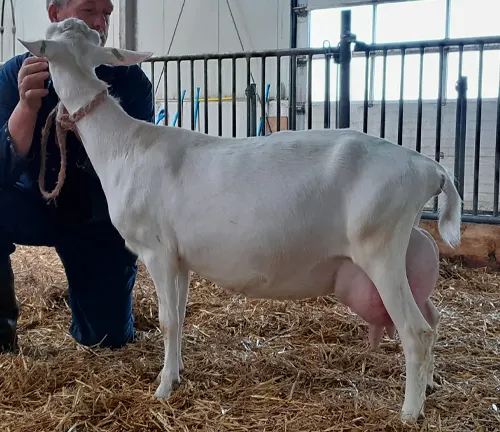
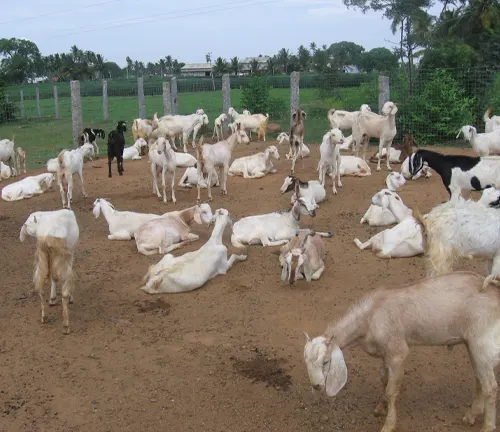
Regular Health Checks
Routine health checks by a veterinarian are essential to monitor the overall health status of Saanen goats. These checks help detect any signs of illness or health issues early, allowing for prompt intervention and treatment. Regular health assessments also ensure that Saanen goats receive appropriate care and management to maintain their well-being.
Proper Nutrition
Providing a balanced and nutritious diet is crucial for the health and productivity of Saanen goats. This includes offering high-quality forage, supplemented with hay, grains, and mineral supplements as needed. Proper nutrition supports overall health, immune function, and reproductive performance in Saanen goats. Monitoring their diet and adjusting feeding practices based on individual needs and seasonal changes is essential for optimal health and care.
Parasite Control
Saanen goats are susceptible to internal and external parasites, which can negatively impact their health and productivity. Implementing a comprehensive parasite control program, including regular deworming, pasture management, and proper hygiene practices, helps minimize parasite burdens and reduce the risk of infestation. Monitoring Saanen goats for signs of parasitic infection and responding promptly with appropriate treatment is crucial for maintaining their health and well-being.
Breeding and Reproduction
Breeding and reproduction management are crucial aspects of caring for Saanen goats and ensuring the long-term sustainability of a breeding program. Here are key considerations for breeding and reproduction:
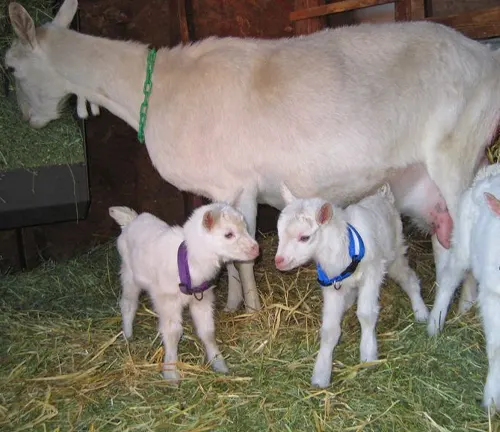

- Selective Breeding: Selective breeding plays a vital role in improving the genetic traits of Saanen goats, such as milk production, conformation, and temperament. Breeders should carefully select breeding stock with desirable characteristics to pass on to future generations, thereby enhancing the overall quality of the herd.
- Breeding Management: Proper breeding management involves planning mating pairs, timing breeding cycles, and ensuring optimal conditions for successful mating. Understanding the reproductive physiology of Saanen goats, including estrus cycles and breeding behaviors, helps breeders optimize breeding outcomes and maximize reproductive efficiency.
- Kidding Management: Kidding management encompasses all aspects of the birthing process, from preparing does for kidding to providing care for newborn kids. Monitoring pregnant does, providing appropriate nutrition and healthcare during gestation, and creating a clean and safe birthing environment are essential for ensuring successful kidding outcomes.
- Reproductive Health: Maintaining reproductive health is critical for maximizing fertility and reproductive performance in Saanen goats. This includes routine health checks, vaccinations, and preventive measures to address common reproductive issues such as infertility, abortions, and dystocia (difficult births).
- Genetic Diversity: Ensuring genetic diversity within the breeding program helps mitigate the risk of inbreeding and preserves the long-term viability of the Saanen goat population. Breeders should periodically introduce new bloodlines and exchange breeding stock with other breeders to maintain genetic diversity and avoid undesirable traits.
- Record Keeping: Keeping detailed records of breeding dates, mating outcomes, kidding records, and individual goat performance is essential for tracking breeding progress, evaluating breeding decisions, and making informed management decisions. Accurate record-keeping facilitates data-driven breeding strategies and helps breeders achieve their breeding goals effectively.
Common Diseases and Prevention
Common diseases can pose significant threats to the health and productivity of Saanen goats. Implementing preventive measures is essential to minimize the risk of disease outbreaks and maintain herd health. Here are some common diseases in Saanen goats and strategies for prevention:
- Mastitis: Mastitis is an inflammation of the mammary gland, typically caused by bacterial infection. It can lead to decreased milk production, quality issues, and discomfort for the goat. Preventive measures include maintaining clean and sanitary milking practices, practicing proper udder hygiene, and promptly treating any cases of mastitis with antibiotics as prescribed by a veterinarian.
- Parasitic Infections: Saanen goats are susceptible to internal parasites such as gastrointestinal worms and external parasites like lice and mites. Implementing a comprehensive parasite control program, including regular deworming, pasture management, and maintaining proper hygiene in living areas, helps prevent parasitic infestations and minimize their impact on goat health.
- Foot Rot: Foot rot is a bacterial infection of the hoof tissue that causes lameness and discomfort in affected goats. Preventive measures include maintaining clean and dry living conditions, providing proper hoof trimming and maintenance, and avoiding exposure to wet and muddy environments that promote the growth of bacteria.
- Caprine Arthritis Encephalitis (CAE): CAE is a viral disease that affects the joints, udder, and nervous system of goats. It can lead to chronic lameness, mastitis, and neurological symptoms. Preventive measures include testing and segregating CAE-positive goats from the herd, pasteurizing colostrum and milk to prevent transmission, and maintaining strict biosecurity measures to prevent the introduction of the virus into the herd.
- Caseous Lymphadenitis (CL): CL is a contagious bacterial infection that causes abscesses in lymph nodes and other organs of goats. Preventive measures include practicing strict biosecurity measures to prevent the introduction of infected animals into the herd, culling affected goats to prevent the spread of the disease, and maintaining clean and dry living conditions to minimize the risk of transmission.
- Clostridial Diseases: Clostridial diseases such as enterotoxemia (overeating disease) and tetanus can affect Saanen goats, causing sudden death or severe neurological symptoms. Preventive measures include vaccinating goats against clostridial diseases, practicing proper sanitation and hygiene, and avoiding sudden changes in diet that can trigger enterotoxemia.
Different Species
The Saanen goat breed itself does not have different species, but there are variations within the breed due to factors such as genetics, breeding practices, and geographical locations.
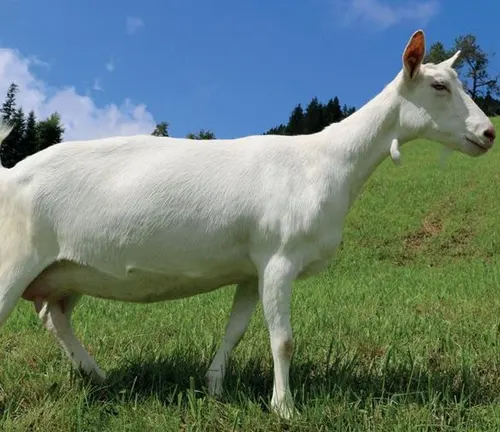
Frequently Asked Questions (FAQs)
- What is the origin of Saanen goats?
Saanen goats originate from the Saanen valley in Switzerland, where they were first bred for their milk production. - What is the typical size and weight of a Saanen goat?
Saanen goats typically have a medium-to-large frame, with females weighing between 135 to 150 pounds and males weighing between 160 to 200 pounds. - What is the temperament of Saanen goats?
Saanen goats are known for their gentle and docile nature, making them easy to handle and suitable for various farming environments. - How do you care for Saanen goats in terms of housing and shelter?
Saanen goats require a well-ventilated barn or shelter with proper drainage to protect them from inclement weather. Access to clean water and comfortable bedding is also essential. - What is the ideal diet for Saanen goats?
- Saanen goats thrive on a balanced diet consisting of high-quality hay, fresh water, and supplemental feed. Access to grazing pastures and mineral supplements is also beneficial.
- What are some common health issues that Saanen goats may face?
Saanen goats are susceptible to diseases such as mastitis, parasites, and hoof rot. Regular health checks and preventive measures are crucial for maintaining their well-being. - How often do Saanen goats need to be vaccinated?
Saanen goats should follow a vaccination schedule recommended by a veterinarian, typically starting at an early age and receiving booster shots as needed. - At what age do Saanen goats reach maturity?
Saanen goats typically reach maturity at around 2 years of age, at which point they are ready for breeding and reproduction. - How long is the gestation period for Saanen goats?
The gestation period for Saanen goats is approximately 150 days, after which they give birth to one or multiple kids. - What is the economic importance of Saanen goats?
Saanen goats are valued for their high milk production, making them a profitable investment for dairy farmers. They also have economic significance in meat production and eco-tourism ventures. - Do Saanen goats require specialized care during kidding season?
Yes, during kidding season, Saanen goats may require additional attention and monitoring to ensure a successful birth and healthy offspring. - Are Saanen goats suitable for grazing in pasture-based systems?
Yes, Saanen goats are well-suited for grazing in pasture-based systems, provided they have access to ample forage and proper management practices are followed.


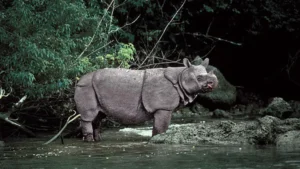
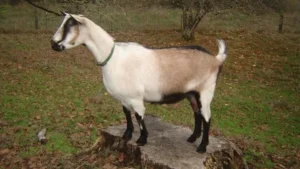






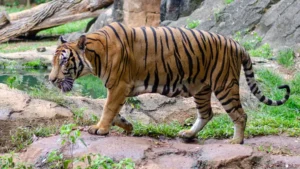
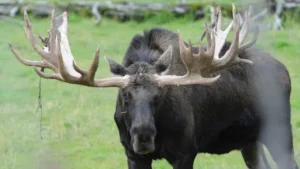

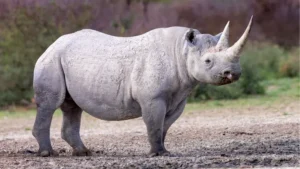
Leave your comment